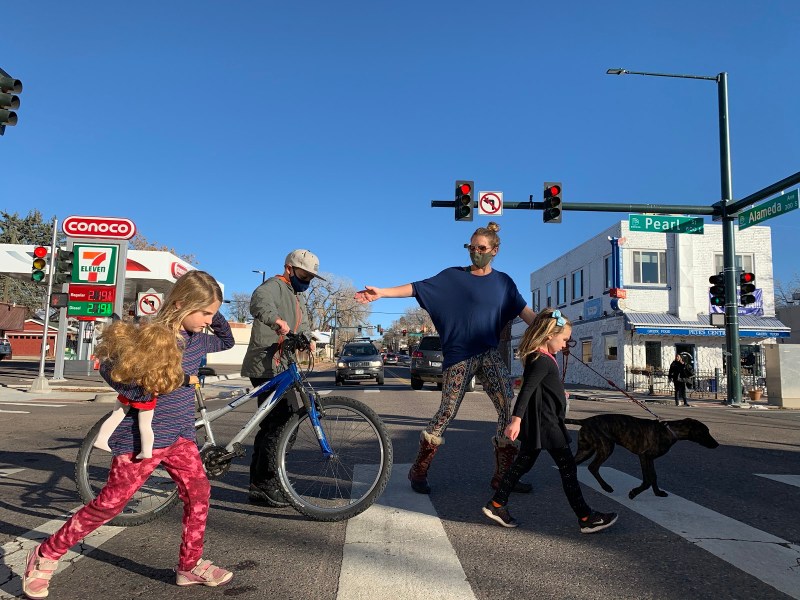Are intersections keeping people from choosing to walk, roll and bike?

West Wash Park resident Kate Gotter worries about crossing Alameda Avenue every time she takes her three children to school. “It’s like playing Frogger. The signal at Pearl is our best option, but most of the time the button is broken.” says Kate “I have three kids, but only two hands. And I refuse to pack everyone into the car just to travel 3 blocks.”
Kate and other vulnerable road users have a good reason to be apprehensive about passing through intersections in Denver—most vehicle-bike conflicts occur at intersections.1
According to Denver Regional Council of Governments, 60% of people in the Denver Metro region would ride a bike but they’re concerned about safety. These “interested but concerned” road users are the target for the Mayor’s goal to increase the combined bike/walk mode share 15% by 2030. Advocates are excited about the 125 miles of bike facilities planned for Denver, and the Department of Transportation and Infrastructure (DOTI) is working on connecting the bike network so that more people may choose to ride instead of drive. The problem is that a connected bikeway system won’t make riders feel safe until intersection safety is also addressed.
Image credit: Denver Regional Council of Governments
Most Denver bicyclists are familiar with the frustration of approaching a traffic signal that requires them to dismount, pull their bike onto the sidewalk and press the beg button to get a light to change for safe crossing. It’s particularly inconvenient for someone riding a heavy bike, recumbent bike or has a child attached to their bike by tag-along. Beg buttons are just one barrier for safely crossing busy streets on foot or bike. Other impediments include:
- Signaled intersections that only turn green when a vehicle is present: When bicyclists and pedestrians do not receive a green light, their only choice is to cross against a red light or jaywalk.
- Signaled intersections that turn green automatically but are not green long enough: When a younger bicyclist or a bicyclist who is not very skilled tries to cross, they are caught in the middle of the intersection when it turns red. This is also true for seniors and those who are mobility challenged.
City budgets for pedestrian and bicyclist infrastructure improvements were already tight prior to the pandemic (it will take 400 years to build out our sidewalk network at the current pace of funding); however, these safety issues can be addressed without much expense and save lives.
Image credit: Denver Streets Partnership
The Mayor’s Bicycle and Pedestrian Advisory Committees have asked for just that. In the Fall of 2020 they sent Mayor Hancock a letter urging him to update the programming of the intersections highlighted on this map.* Additionally, they requested that DOTI study the retiming of these intersections to determine which safety improvements can be made city-wide. The letter also identifies the need for an audit of intersections along the High Injury Network and other intersections with a high number of crashes to ensure that pedestrians and bicyclists receive a green light and leading pedestrian signal with every signal change. Safe crossings are a basic dignity that vulnerable road users deserve when traveling with children, carrying groceries or riding a bike to school.
DOTI responded to the letter by saying that the city is developing a tool to compile data for uncontrolled pedestrian crossings to prioritize pedestrian crossing improvements “with a focus on equity, safety and vulnerable road users. Improvements can range from temporary, near-term improvements like paint and post curb extensions, to new signals, which are more expensive and permanent.” In addition, the rapid response team has been investigating locations where fatal crashes have occurred and implementing rapid safety improvements.
To assist DOTI in identifying dangerous intersections before a crash occurs, please report issues to Denver 311. You can do that by dialing “311” on your phone or you can visit PocketGov.com to report an issue. Tip: save the case number so you can use it when you email your city council person to follow up on the progress of the issue!
* This list is not comprehensive but includes intersections identified by members of the Mayor’s Pedestrian and Bicycle Advisory Committees.
Sign up for our daily e-mail digest and never miss a Denver walking, biking, or transit story.




